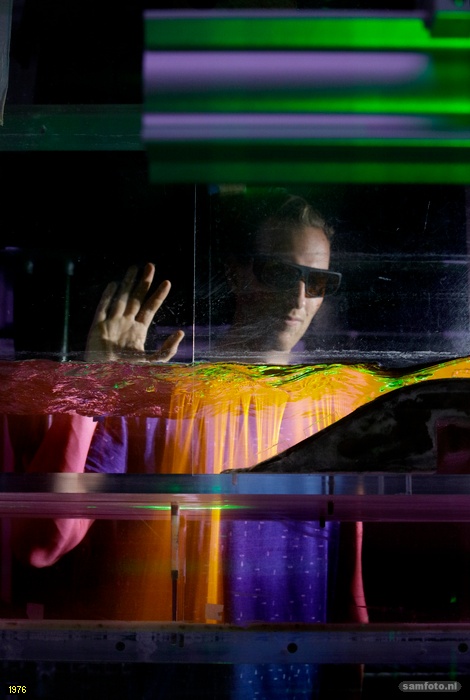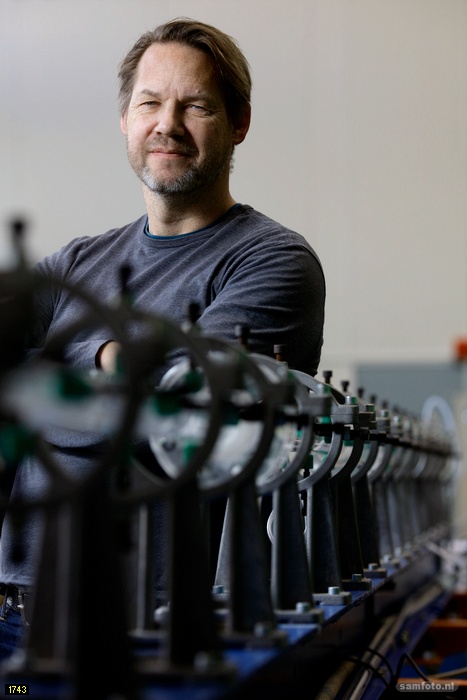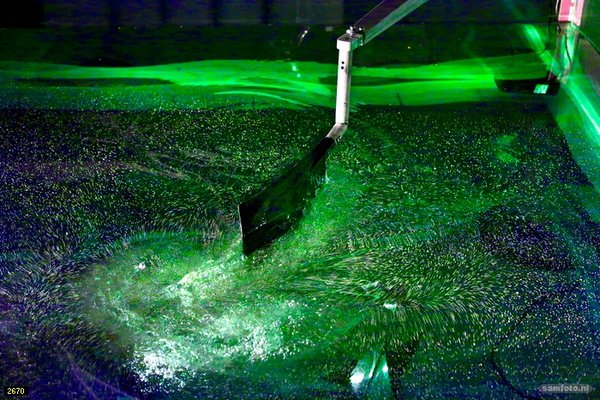TU Delft celebrates a century of fluid dynamics
One hundred years ago, Jan Burgers was appointed professor of fluid dynamics at Delft. Professor Jerry Westerweel looks back on this field and three young researchers look ahead.
The nice thing about fluid dynamics is that it all takes place at a human scale; water flows under a bridge, clouds glide through the air, and when it rains you get wet.
People like Jerry Westerweel, who is a professor of fluid mechanics, see fluid dynamics everywhere around them: in turbulence, blood circulation, pollution or wind turbines. Everything flows. If you want to see the world through the eyes of an expert in fluid dynamics, the FYFD website has an endless supply of mesmerising footage of falling drops of water, quadruple rainbows, spontaneous avalanches or bats in flight.
A century ago, professors C.B. Biezeno and C.P. Holst decided that the mechanical and maritime engineering department needed a new lecturer who could lay a theoretical foundation for a better understanding of fluid dynamics. Leiden University professor Paul Ehrenfest, alerted his former doctoral candidate Dr J.M. (Jan) Burgers to the vacancy. Back then, Burgers was working on atomic theory for the legendary professor Henrik Lorentz, but he started to wonder if this field was really his destiny.
Burgers started work at TU Delft in October 1918, and two years later a wind tunnel and towing tank were ready for use . Burgers talks about this in his memoirs, which he wrote down in 1975 in Maryland (USA). Under his leadership, theory and experimentation came to be seen as a whole, an approach that still characterises fluid dynamics at TU Delft today. This was also mentioned during the ‘Flows are everywhere’ symposium on 18 October celebrating a century of fluid dynamics at TU Delft, where three young researchers also presented a glimpse of the future.
Changing measurement techniques
But first a look back at this fascinating past. Would Jan Burgers still recognise his laboratory today? Westerweel (born 1964) thinks not: “We have a cabinet filled with old instruments, but everything else about measurement technology has changed completely. A wind tunnel is always a wind tunnel – it was one of the earliest ideas – but the technology for measuring in it has changed tremendously. Burgers measured wind speeds and turbulence with a filament. The rate it cooled down was a measure of the speed at that point, and the turbulence could be estimated based on the variation in this speed. Back then turbulence was the most important area of research, as it still is today. Back in the 1960s, the brilliant physicist Richard Feynman said that turbulence was one of unresolved problems of physics; even he wasn’t prepared to take it on.”
Swimming with the sharks
Most progress over the past century has been made in measurement technology and processing power, says Westerweel. “Burgers measured a single point with his filament. Today we can measure a hundred thousand points at once. The measurement volume is about the size of your wallet, but we are now expanding into larger volumes. We recently studied the shark aquarium at Blijdorp zoo. We wanted to see if we could track a shoal of a thousand false herring while it was being attacked by a shark, whereby we scaled up the measurement technique from 10 x 10 centimetres to 10 x 6 metres and 25 metres deep.

Waves on flowing water focus striking laser light in illuminated tracks. PhD student Mike van Meerkerk investigates the occurrence of instability on a water surface, using a standing wave of water that flows from right to left over an obstacle. Photo © Sam Rentmeester
Fluid dynamics are everywhere; in turbulence, blood circulation, or wind turbines. Everything flows
Two divers swam in the tank with a calibration plate while a third diver was on hand with a pole to keep the sharks away. We set up four synchronised cameras and shot three-dimensional images to reveal how a shoal of herring separates and reforms when a shark penetrates it.”

Professor Jerry Westerweel. Photo © Sam Rentmeester
Flow calculations gained sway in the 1980s when computers finally had enough processing power. The more turbulent the flow, the more complex the calculation. The Reynolds number is used as a measure of turbulence. It roughly describes the ratio between flow velocity and viscosity. A rule of thumb is that a flow will switch from laminar to turbulent at a Reynolds number of 2000. “Successful simulations are now conducted with increasingly higher Reynolds numbers,” says Westerweel. “When I got my PhD in 1993, the flow in a tube could be accurately simulated up to a Reynolds number of 5000. Today the simulation threshold is 50,000 to 100,000, which makes it interesting for industry. Industrial issues can now be analysed using Large Eddy Simulation, a mathematical model for calculating flows.” He picks up an iPad and taps the screen. A current flows round obstacles which leave eddies in their wake. “You can see how the eddies are shaken off,” explains the professor of fluid mechanics. “In the late 1980s and early 1990s you would have needed a supercomputer for this; now you can run it on your smartphone.”
The next century
The current generation of fluid dynamics researchers have access to 3D measurement technology and powerful computers to calculate their Navier-Stokes equations. Around them, the world is changing, and with it the applications of their field. Within the next hundred years, the focus may well shift from refineries and diesel engines to wind turbines, geothermal energy, heat pumps and exchangers.
Westerweel does not venture predictions; he leaves that to three 30-year-olds who have a fresh perspective of the century-old field. At the Fluid Mechanics Centennial symposium, organised together with the J.M. Burgers Centre, Dr Daniel Tam of TU Delft, Dr Alvaro Marin of the University of Twente and Dr Hanneke Gelderblom of TU Eindhoven presented their visions of the next century of fluid dynamics.
“Why do all those painstaking calculations?” Gelderblom wondered aloud to a room full of fluid dynamics experts. Neural networks and self-learning systems are used everywhere, so why not in fluid dynamics? Could you enter flow data into a trained neural network and then just sit back and watch what the system produced? Who would still need Navier-Stokes equations? Gelderblom quickly quashes her own thought experiment with the conviction that any problem analysis will always need to fall back on the theory; aimless calculations will never replace careful problem analysis.
Mindless processing power
But Gelderblom is not the only one who is attracted to the idea of cheap processing power. Daniel Tam, who was voted teacher of the year by the ME faculty last year, notes that it is difficult to explain to students what the physical principles behind the observations are and why they are important . “Students would rather run the entire experiment through MATLAB and let the computer do the maths,” says Tam.
The relationship between experimentation and simulation is shifting towards cyberspace. Increased processing power and improved numerical methods have made simulations cheap and reasonably reliable. Researchers can use computers to run simulations that cannot be reproduced in real-life experiments.
But Tam still has some reservations. “We don’t really know how to use computers yet,” he thinks. Computer models generate mountains of data, often more than researchers can use. “For fluid dynamics, you can suffice with the speeds in the x, y and z directions and the pressure. But a computer model includes the temperature too and then it really goes crazy.”

A rowing blade (scale 1:2) moves through a horizontal plane with laser light while a camera captures the flow under the setup through 10 cm thick glass. PhD student Ernst-Jan Grift investigates accelerating and slowing currents around the blade to see how rowers can go faster. Photo © Sam Rentmeester
The most common way to analyse fluid dynamics with a computer is using Computational Fluid Dynamics (CFD), but it produces such a huge amount of data that an extensive post-processing step is required to render it useable.
Speaker Alvaro Marin has also seen how experiments are being replaced by computer simulations, particularly when it concerns large Reynolds numbers. But Marin still thinks the results of simulations must always be validated with experimental data, because models may be incomplete, researchers may miss something, or there may be a programming error in the simulation. Finally, it is also safer if you know that your predictions correspond to the actual situation.
Exotic fluids
In addition to simulations and experiments, the younger generation also points to the further development of the theory of complex and nanoscale fluids. For example, Tam is studying fluids at the scale of living cells, where it appears that fluids can move under their own power without an external driving force. These fluids are also no longer homogeneous, which makes the Navier-Stokes equations much more complex. The same applies to fluids to which polymers or microparticles have been added. The industry is developing more and more exotic fluids such as fast-drying or adhesive ink that work well in practice, but about which little is understood. The theoretical foundation of fluid dynamics will need to be developed further if it is to continue to play a meaningful role in the development of strange fluids, giving a strong theoretical foundation for us to understand more about fluid dynamics. Funnily enough, that's the same assignment that was given to Jan Burgers when he was appointed at Delft a century ago.
Fuck Yeah Fluid Dynamics: fyfluiddynamics.com
